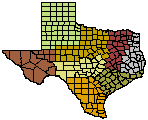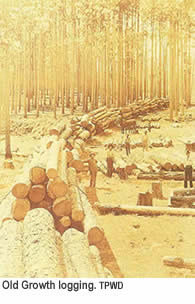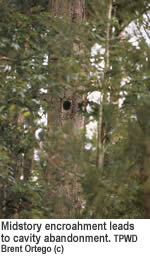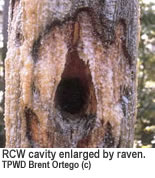- Trans Pecos
- High Plains/Panhandle
- Cross Timbers
- Hill Country
- Post Oak Savannah
- Pineywoods
- Oak Prairie
- South Texas Plains

Wildlife Division District Map
Pineywoods Wildlife Management
Endangered Species
Threats and Reasons for Decline
 The
main threat to the survival of the Red-cockaded Woodpecker is the decrease
in the quality and quantity of old growth forest nesting habitat, primarily
due to short rotation timber management. Fire suppression has also been detrimental
due to the importance of controlling the midstory in Red-cockaded habitat.
Because of this bird's requirement for old age pines, habitat loss takes along
time to rectify. It may take 60-70 years to begin to provide suitable nesting
habitat. Ideally, rotation ages of 100 years for loblolly, and 120 years or
more for shortleaf and longleaf pine are needed to produce trees with the
required amount of heartwood and frequency of red heart fungus.
The
main threat to the survival of the Red-cockaded Woodpecker is the decrease
in the quality and quantity of old growth forest nesting habitat, primarily
due to short rotation timber management. Fire suppression has also been detrimental
due to the importance of controlling the midstory in Red-cockaded habitat.
Because of this bird's requirement for old age pines, habitat loss takes along
time to rectify. It may take 60-70 years to begin to provide suitable nesting
habitat. Ideally, rotation ages of 100 years for loblolly, and 120 years or
more for shortleaf and longleaf pine are needed to produce trees with the
required amount of heartwood and frequency of red heart fungus.
 Some
of the potential adverse effects of modern forestry on Red-cockaded Woodpecker
habitat are: 1) short timber rotations (30 to 45 years) which result in loss
of suitable nesting and roosting habitat, (2) leaving only cavity trees and
cutting all others within a cluster reduces foraging habitat and does not
allow for cavity tree replacement, (3) leaving isolated clusters surrounded
by harvested areas reduces foraging habitat and may increase predation by
forcing birds to cross large open areas, (4) removing all dead and dying trees
results in loss of habitat for other cavity-nesters, thereby increasing competition
for Red-cockaded Woodpecker nest cavities, (5) preserving cavity trees and
removing other dominant trees in a colony makes the cavity tree the tallest
in the area and subject to lightning strikes and wind damage, (6) careless
use of pesticides may poison the birds directly or decrease there food supply
below the minimum level needed for reproduction, and (7) noise and activity
of forestry operations in the vicinity of a colony during the breeding season
can disrupt nest success.
Some
of the potential adverse effects of modern forestry on Red-cockaded Woodpecker
habitat are: 1) short timber rotations (30 to 45 years) which result in loss
of suitable nesting and roosting habitat, (2) leaving only cavity trees and
cutting all others within a cluster reduces foraging habitat and does not
allow for cavity tree replacement, (3) leaving isolated clusters surrounded
by harvested areas reduces foraging habitat and may increase predation by
forcing birds to cross large open areas, (4) removing all dead and dying trees
results in loss of habitat for other cavity-nesters, thereby increasing competition
for Red-cockaded Woodpecker nest cavities, (5) preserving cavity trees and
removing other dominant trees in a colony makes the cavity tree the tallest
in the area and subject to lightning strikes and wind damage, (6) careless
use of pesticides may poison the birds directly or decrease there food supply
below the minimum level needed for reproduction, and (7) noise and activity
of forestry operations in the vicinity of a colony during the breeding season
can disrupt nest success.
 Finally,
southern pine beetle infestations have been found to be a major cause of cavity
tree loss in Texas. This is particularly true during southern pine beetle
epidemics, such as the one that occurred on the Sam Houston National Forest
in 1983 following hurricane Alicia. Active management is needed to reduce
the loss of cavity trees to southern pine beetles.
Finally,
southern pine beetle infestations have been found to be a major cause of cavity
tree loss in Texas. This is particularly true during southern pine beetle
epidemics, such as the one that occurred on the Sam Houston National Forest
in 1983 following hurricane Alicia. Active management is needed to reduce
the loss of cavity trees to southern pine beetles.
The 1994 post-breeding population estimate for the Red-cockaded Woodpecker in Texas was 925 birds. An estimated 685 birds (74%) were found on federal lands (National Forest and National Park), 181 birds (20%) on private lands (timber companies and other private landowners), and 59 birds (6%) on state lands (State Forests and other state lands).
 (
(